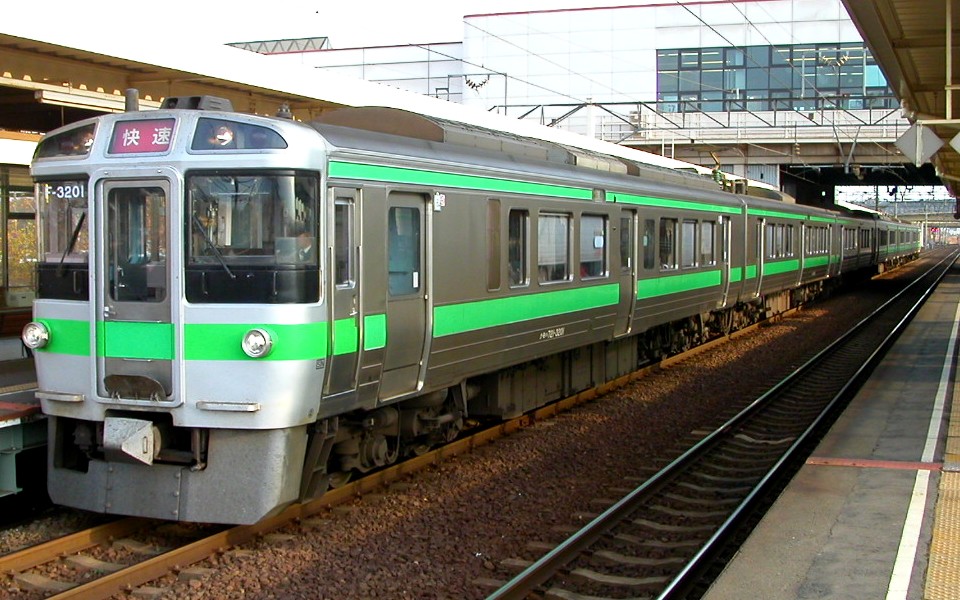Sapporo is the fifth largest city in Japan, so when you arrive here the public transportation system may feel a bit intimidating. Worry not, as it is very simple, reliable and easy to use!
While especially during spring and summer it is so lovely to explore the city on foot or by bike, some attractions or other places of interest may be quite far. In case of sudden rain (or during winter) hopping on a streetcar to see the city or taking a subway back to your hotel may be a nicer option. This guide is here to give you all the information you need in order to decide what kind of transportation you want to use to make your stay here smoother.

The Subway

The first option that you have for travelling around the city is the subway. Compared to Tokyo or New York, Sapporo’s subway system is super simple, as it only has 3 different lines: Tozai Line (yellow), Toho Line (blue), and Namboku Line (green). Both Toho and Namboku line go via Sapporo station (which is where you’ll arrive if you decide to take the train from New Chitose airport). All three lines stop at Odori station, which is right in the heart of the city, and very near to many attractions like the Odori park, Sapporo clock tower, and the TV-tower.
Finding the stations may be a bit tricky if you don’t know what you’re looking for. The symbol for subway stations is as shown below. Google Maps is a great way to locate the nearest station as well. If you don’t have data, most cafés, convenience stores, and even the JR station offer free wi-fi.
The most important decision when taking the subway is the type of ticket or pass you’ll be getting. If you are staying here for just a few days, I recommend getting an unlimited one day ticket, which allows you to ride as much as you want to for the duration of the day. Especially if you’re here only for the weekend, as the Donichika-pass (weekend one-day ticket) is only ¥520. The tickets are sold at each station, but you can only purchase a ticket for the day, and not the whole week (or however long your staying) in advance. Day tickets are only valid on the subway, not for other forms of public transportation (which have their own day tickets). When using a day ticket, you enter it into the small slot in the gates, and it pops out on the other side for you to collect. You can walk through the gate as you do this.
If you’re staying in Sapporo for a longer period of time, it is worth considering getting a subway pass, like the Sapica IC card. (Note that this card can be used only in Sapporo. If you plan on traveling around Japan, it is better to get a card which is accepted all over the country, such as Suica or Kitaca). Like the day tickets, these can be purchased at every station. When you first get the pass, you will pay for both the card (¥500 deposit, which you will get back once you return the card) and the spendable money on the card (¥1500). You can recharge the card at a separate machine.
There are two types of Sapica cards you can get. The open card can be used between multiple people, while the registered card is personal and requires a Japanese phone number, which as a tourist you probably don’t have. It is completely up to you if you want to share one open card among your group (needs to be recharged more often) or get one for each of you (multiple deposits, but quicker to move around, as you don’t need to hand it over to the next person).
Sapica IC card can be used on the subway, the bus and the streetcar. When entering a subway, you tap the card on the reader, and walk through the gate. When exiting a subway, you do the same. If your card does not have enough money for the fare (min. ¥200, max. ¥360 per ride) and you can’t get through the gates when exiting, you can recharge it at a machine within the gates.

When waiting for the subway, it’s good to know that it is common to form two lines per door. It is also considered common courtesy to leave room for those exiting the subway first, and entering only after people have managed to come out.
The Streetcar

If you don’t plan on going far from the central area you may want to hop on the streetcar. The streetcar is also a fun and easy way to see a bit of the city, without spending all day walking around. The streetcars go in a loop in the south-western part of the city. You can choose to travel either clockwise (outer loop) or counter-clockwise (inner loop) depending on which is closer to your desired destination. Each stop has a clear map showing at which stop you are at the moment and to which direction the streetcar goes. I’ve also found that Google Maps is pretty good at giving directions for the right stop.
If you have a Sapica card, paying for the ride is simple: just tap the card on the reader when exiting the streetcar. If you don’t have the card, you can also use cash (flat fare for one ride is ¥200 for adults and ¥100 for children). You can also get an unlimited dosanko day ticket at the streetcar or at Odori Station Commuter Pass Sales Office. Whichever way of payment you choose, remember to enter from the backdoor and to pay for the ride right before exiting through the front door.
The Bus

Sapporo has multiple bus companies and taking the bus can be a bit of a hassle. However, if you want to visit some places which are out of reach of the subway or streetcar, a bus may be able to take you there. While the buses are reliably on time, there may be changes on the timetables according to whether it is a national holiday or not. This can be difficult to figure out if you don’t speak Japanese, so it’s best to check Google Maps before going to the bus stop.
Riding the bus itself is very simple. As I mentioned before, Sapica IC cards can be used on buses within the city. The fare depends on the distance you travel. When entering the bus (through the backdoor) tap the card on the reader and find a place for yourself. If you don’t have a Sapica IC card, or you doubt that you have enough money for the ride, you can take a small numbered ticket from the machine next to the backdoor. When you are approaching your destination stop, press one of the buttons spread around the seating area. When getting off, just return the ticket to the driver and pay the asked fare, or tap your Sapica IC card on the reader.
For stress free long-distance journeys, contact us for our charter bus services! We’ll help you design your personalized travel experiences! We can organise door-to-door transport for individuals, small groups and all the way up to groups of up to 40+.
The Taxi

If you want a ride straight to your hotel door, you can hail a taxi. Taxis in Sapporo are easy to use, with automatically opening doors and friendly drivers. However, they can be quite expensive, as the starting tariff is a bit over ¥500 with additional ¥300 every kilometer. See more price estimates here.
Uber or Lyft do not operate in Sapporo, but the taxi-hailing service Didi has expanded to the biggest cities in Hokkaido.
The Train

Chances are you begin your Hokkaido adventure by taking a train from New Chitose airport to Sapporo station. One-way ticket from the airport to Sapporo costs ¥1070 and trains depart every 15 minutes or so. Taking the train from the airport is by far the easiest and cheapest option.
If you are travelling from Sapporo to other parts of Japan (or vice versa), taking the train is a good option (and more sustainable than flying!). If your travel plan includes a lot of train rides across the country, it may be worth getting a Japan Rail Pass. An important thing to remember is that you’ll have to purchase it before your departure. More information on the Rail Pass can be found here. Note that the Rail Pass is not applicable on every train route.
It is possible to take the shinkansen (bullet train) from Hokkaido to Tokyo. However, the shinkansen leaves from the southern point of the island, Hakodate. To get there from Sapporo, you’ll need to make a 3,5-hour journey first. The shinkansen from Hakodate to Tokyo (or the other way around) takes approximately 4 hours. Japan Rail Pass can be used for the Hakodate – Tokyo route.
If you are looking to travel only to a couple of towns near Sapporo, the Rail Pass may not be the cheapest option. JR Hakodate Main Line covers the main cities of Hokkaido. For more information, check out the Sapporo Station website.
Important to note
There are a couple more things to be aware of while using the public transport.
1) The pedestrian traffic tends to follow that of the vehicles, so when walking around the station, and especially on stairways, do try to stick to the left-hand side.
2) At first, especially the bigger stations may feel overwhelming and chaotic. However, there are signposts for each subway line and exits dotted around, usually with some English as well. However, if you do feel lost and decide to rely on your phone’s map app, try not to suddenly stop on your tracks. Rather, move to the side or next to a pillar to avoid collision with others. Sapporostation.com offers a good guide to the JR station. If you do find yourself lost and without internet, the largest stations have information desks. The staff may not speak perfect English, but with simple sentences or simply using single words, you should be able to get help.
3) In Japan it is considered rude to make noise in public transport. Many places have no-phones signs, which mean you should keep your phone on silent and to not answer any calls while using the public transportation. Try to also avoid speaking too loudly, or playing any music.
Useful phrases to know
Does this subway/ bus/ streetcar go to ___?
Kono chikatetsu/ basu/ shiden wa ___ ni ikimasu ka?
How much does the ticket cost?
Kippu wa ikura desu ka?
Do you speak English?
Eigo ga hanasemasu ka?
Sorry, I don’t understand.
Sumimasen, wakarimasen.




